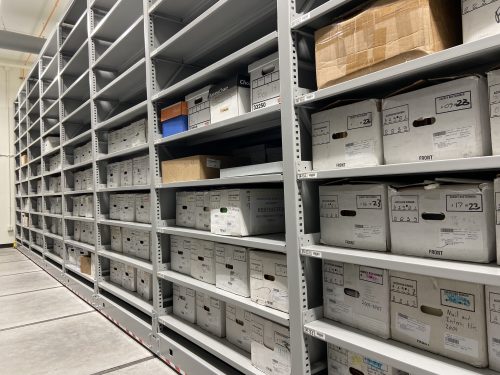
My name is Kate Trathen, and in January I started working as the Richard Burr Congressional Collection Archivist at ZSR Library. I am a Raleigh native, and I received my Masters of Library Science with a concentration in Archives and Records Management from UNC-Chapel Hill. Prior to starting at Wake Forest, I was the Electronic Processing Archivist at the South Carolina Department of Archives and History in Columbia, SC. I will be blogging periodically about my progress with processing the Burr papers throughout my time working on them, so you can follow along throughout the two-year process from beginning to end. But first, a bit about Senator Burr.
Richard Burr was born in Charlottesville, Virginia, but grew up in Winston-Salem. He attended Reynolds High School, and went on to Wake Forest University on a football scholarship, 1974-1978. He first ran for U.S. Congress in 1992, but lost to Stephen Neal. However, in 1994, he was elected to the House of Representatives, where he served until 2004 when he was elected Senator, filling John Edward’s seat. His most notable accomplishment as Senator was serving as the Chairman of the Select Committee on Intelligence, a position he held from 2015-2020. In 2018, after announcing that he would not seek reelection, Senator Burr agreed to donate his congressional papers to Special Collections and Archives. This January, I was hired to do the work of archiving them so they can be accessible for research. With an initial box count of 453 boxes (plus memorabilia), I will have my work cut out for me!
The first step in processing any archival collection is to go through the materials and figure out what you have. Depending on the size of the collection, this might take anywhere from an hour to a few days. In this case, it took me about two months to complete this step. I looked through each and every box of the collection, taking notes on what I found in each box. I wanted to understand what types of files were in the collection, which would help me make a plan of how to arrange them. I also needed to research Richard Burr’s career–his accomplishments, positions he held, and issues he cared about. A major source for this research was Burr’s farewell speech in the Senate, given in January 2023. In this speech he outlined, from his own perspective, the most important aspects of his time in Congress, including major legislative accomplishments, committee service, and leadership positions held. This speech was crucial in helping me understand Burr’s priorities and interests, which ranged from healthcare to national security.
After completing the inventory and initial research, it was time for me to write a processing plan. This was when I went into detail about my plans for the collection. I sorted the 453 boxes into five series based on record type: constituent files, legislative and subject files, memorabilia, personal and administrative files, and press files. I also outlined the steps I would take for each series. For example, memorabilia will require intensive appraisal and selection of the items with the most informational value for researchers, or value for future exhibits of the collection. Press files will not require appraisal but will need to be rearranged and put in new folders and new boxes. Lastly, I set a timeline for myself to complete all of the work that I will need to do. Because this project is so massive, it will be important for me to stay on track. However, I’ve learned that in archival work things don’t always go as planned, and unexpected roadblocks are likely to show up along the way. I built some extra time into my timeline to account for these potential roadblocks and will continue to modify the timeline as I go, over the two years of this project.
After completing my processing plan, the real work began! I have been hard at work going through boxes, rearranging files, labeling folders, and making folder lists. I will go more in-depth on this process in future blog posts.

6 Comments on ‘Planning and Processing of the Richard Burr Collection’
Great work Kate!
Thanks, Kate, for all your hard work!
Thanks for the update, Kate! This is fascinating.
This is great Kate! Thank you for sharing your journey with this collection.
Thanks for the insights into your process, Kate! I learned a lot from reading your post.
Thank you for sharing the behind-the-scenes view of processing such a large and unique collection!